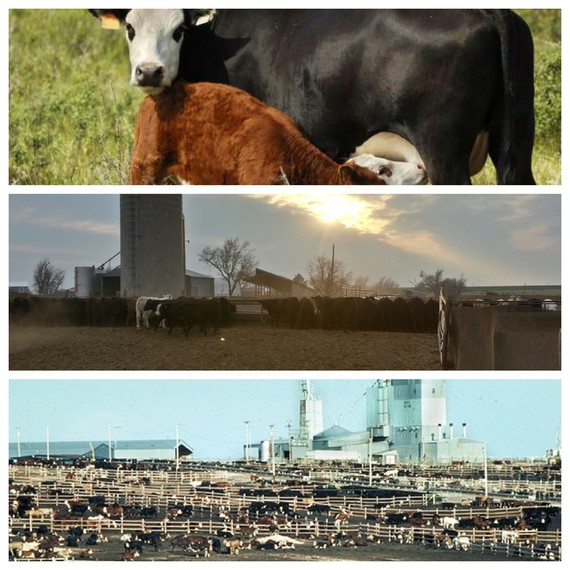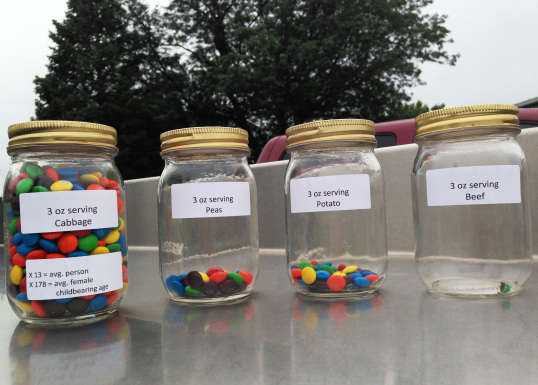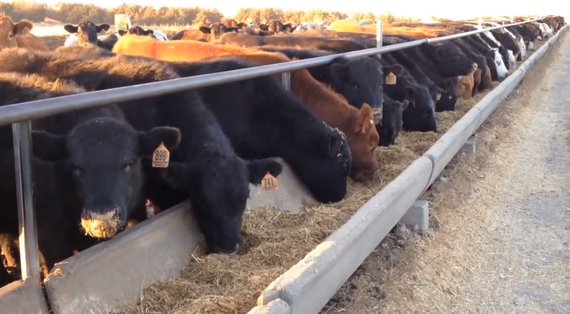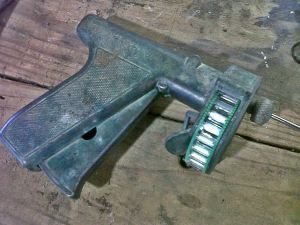In Part 1 of this four-part blog series, we discussed how we believe Chipotle is misleading consumers with their advertisement videos "The Scarecrow" and "Farmed and Dangerous." The blog laid out the 3 definitions of farming that we believe Chipotle has gotten wrong. Part 2 expanded on the first definition: The definition of a family farmer. Part 3 covers the second definition: The definition of a humanely raised animal.
The way I would define "humanely raised" in the animal agriculture sense is:
Treating animals with care and respect, keeping animals healthy, and allowing animals to live comfortable lives.
I believe that the vast majority of farmers, both conventional and organic, are doing just that. Any true livestock farmer will tell you that in order to make a profit in the livestock industry, you must treat your animals well. This is especially important in today's livestock economy, as higher buying costs and higher feed costs have allowed for a very thin margin of profit. One of Chipotle's prevalent claims in their marketing videos is that animal agriculture abuses animals because we are motivated only by greed and money. I would argue that it wouldn't make any financial sense to abuse our animals or raise them incorrectly. If we did then we would fail miserably, and in turn we would lose money. If our animals are not treated with care, not kept healthy, and not kept comfortable, our slim, marginal chance of being a successful livestock farmer is absolutely destroyed!
Based on my years of experience in the agricultural community, I believe that nearly every animal in this country is treated ethically, with care and respect. I do agree that there are a few exceptions, many of which can be found on YouTube and animal activist websites, where animals are being abused on farms. These videos make me sick to my stomach because I as a farmer love animals just as much as anyone, and everyone in the agricultural community is ashamed of these videos as well. It is a horrible misrepresentation of the way that the vast majority of the livestock community actually raises their animals.
However, these few exceptions are allowing animal activists to promote the idea that all of animal agriculture is an abusive industry, even though only a few cases have been reported. Think about it, there are around 10 billion animals raised for meat production each year in the United States and there are only a handful of videos that come out each year. That in no way makes those terrible incidents okay, but it goes to show that the OVERWHELMING majority of livestock farmers treat their animals with care and respect. We in the agriculture community are working to stop those isolated cases and WILL NOT TOLERATE the mistreatment of animals!
I will now address how we treat our animals humanely as cattle farmers. I won't take the time to address the other livestock farming operations (dairy, poultry or swine) but I can assure you that they treat their animals just as humanely as we do. Farms of any type are extremely regulated in order to assure quality and ethics. Don't believe me? Please, tour a real farm and ask a real farmer, live and in person! (Don't rely on Internet articles!)
How do we treat our animals with care and respect?
One of the reasons we keep our cattle in confined areas is because it makes it a whole lot easier for us to care for them! When animals are out on "free-range" pasture (like Chipotle requests) they may not be as available to the farmer, as he is not always around to check on how they are doing. Keeping animals on the location of your farm is a lot more convenient, a lot less work, and a lot more practical. When confined on the farm, a farmer can check on the animals multiple times per day and treat them at the first sign of sickness, which leads to a greater chance of recovery.
Of course, this isn't to say that free-range pasture fed cattle aren't well taken care of! Most people don't realize that beef cattle spend most of their lives on free-range pasture grass, whether conventionally raised or not! This is something that Chipotle and many people on the Internet really can't seem to get straight. Beef cattle are born and raised on pasture grass with their mama cows, weaned after about a year and sent to farmers like us who feed them specific nutrients (minerals, alfalfa hay, and corn silage) designed for efficient and healthy beef production. Near the very end of their lives, they are sent to finishing farms where they are fattened before butchering.

Step 1: Cattle spend the majority of their lives on grass pasture with their mama cows.
Step 2: Cattle are weaned off of their mama cows and taken to backgrounding feedlots like my family's.
Step 3: Cattle are fattened at finishing farms.
I do not believe that any of these steps in the beef production process are "better" than the others, just like I don't believe organic farming is better than conventional. Having cattle out on pasture is great and is probably the most ideal, as long as there is enough grass. However, during the winter, the grass doesn't grow and is often covered with snow in most places. Even farmers who normally have cattle on grass usually bring them back to confinement during the winter where there is plentiful food and shelter from the elements. Grass only grows for a few months out of the year and thousands of acres of grassland are being taken away each year due to urban sprawl. This also means that there little grass pasture for sale, and if it does sell it goes for as much as $3,000 an acre, which can make it tough for any farmer to raise cattle on grass. So, while the idea of all of our cattle grazing on a wide-open field is great, there is absolutely no way that all of the beef cattle in this country could be raised on pasture grass.
In summary, each step of the beef cattle process serves a purpose, and all are needed for the most efficient process possible. Efficiency means healthier cattle, healthier cattle means less work for the farmer, and less work for the farmer means a greater chance for profit! Yes, a farmer is concerned about his ability to stay in the business he loves, but he is also just as concerned about the well being of his animals. Don't believe me? Visit a real farm and ask a farmer!
How do we keep our animals healthy?
Animals get sick sometimes, just like humans. And just like humans and their doctors, there are methods farmers and veterinarians use to help prevent and treat sickness in animals.
We give our cattle preventative care as soon as they arrive on our farm to make sure they are less prone to sickness. This process begins with a liquid that is poured onto the back of the cattle to prevent worms and lice. It also includes two small shots of vaccine and a nasal application that size-wise are all three equivalent to about a teaspoon (2 mL). These vaccines all help our cattle build immunity to prevent sickness. Humans are constantly trying to keep themselves from getting sick (vaccines, vitamins, preventative medicines), so we should be able to understand this process.
Our cattle are also given antibiotics when they do get sick to help them back on the road to recovery. If we were to refuse to give antibiotics to animals (like Chipotle requests) their chance of survival would be minimal, leading to a lot of suffering and eventually death. Now that's what I would call inhumane! This is why there usually aren't adequate antibiotic-free meat supplies for Chipotle to use. There aren't many farmers willing to treat their animals with that kind of neglect. Without antibiotics, you are risking the health of your animals, and by risking the health of your animals you are risking your ability to make money. What kind of farmer is interested in that?
To be clear, when we do give our animals antibiotics, the recommended dosage comes from a professional veterinarian. The amount is a smaller (weight-based) dosage than that which you would give to your children (Typically about 10 mL per head). The antibiotics are given into the bloodstream of the animal and the FDA requires antibiotic withdrawal for a specific number of days before the animal is butchered to ensure there is no residue remaining in the animal. The FDA also prohibits excessive use of antibiotics, which is why Chipotle's depiction ("pumping" it into animals) in their commercials is absolutely false and downright offensive to cattle farmers everywhere.
Another requirement of Chipotle's "healthy meat supply" is that it has to be "hormone free." Cattle farmers have been using growth hormones for nearly 60 years. (Swine and poultry do not use growth hormones, as there is no added benefit.) The USDA and the FDA require these hormones to undergo scientific testing to make sure they're safe for the animals and humans. Chipotle depicts hormone use in cattle as excessive, unsafe, and detrimental to the quality of the meat. Again, this is so far from the truth!
Our cattle, like most beef cattle, are given growth hormones to help them convert their feed into lean muscle more efficiently. People are demanding leaner cuts of beef and this is a safe way to produce it. The growth hormones are given into the ear of the animal as a tiny implant about the size of a tic-tac. That's it. One of the biggest misconceptions Chipotle is portraying is the amount of hormones that go into cattle.
Check out this comparison of hormones in beef compared to other foods:
Read more here: http://nefb.wordpress.com/2013/08/23/whats-the-beef-mms-and-hormones/
"One serving of beef from a steer implanted with a growth promotant has nearly 20 times less estrogen than what the FDA permits and thousands of times less than what our bodies naturally produce, not to mention a fraction of what is present in many other foods such as cabbage and grains." - Beef Checkoff
As you can see, there shouldn't be any concern with giving growth hormones to cattle. The cattle aren't growing unnaturally when given growth hormones, they are just using their growth ability more efficiently and producing healthier, leaner beef. And, just like with antibiotics, the FDA requires that all animals go through a growth hormone withdrawal period to ensure that everything has worked its way out of the animal's system before that meat can enter the food supply.
How do we allow our animals to live comfortable lives?
This is a subject in which there are many differing opinions. One person's definition of an animal living a comfortable life is completely different from another person's definition. Chipotle's commercials depict conventionally raised animal's lives as completely miserable. This is another outright lie that is frustrating farmers everywhere, and I believe is only portrayed that way so that consumers are saddened into buying Chipotle's products that are coming from "happy cows."
The appearance of CAFOs (large animal confinements of over 1,000 head, like our farm) may sometimes convey that conditions are causing animals to live their lives in suffering, simply due to the sheer volume of animals in one place. I've already covered the reasons why confinements allow farmers to care for animals more efficiently. But, you may still be asking, are the animals actually comfortable in these confinements?
This is where I must encourage you to visit an actual real-life farm of this proportion, whether it is cattle, poultry, or swine. Videos, words, and pictures can too easily be manipulated to fit either side of the agenda. I spend many hours each day with our cattle and have had plenty of time to observe and I can assure you, they look to be about as comfortable as cattle can be!

This video shows how we treat our cattle on our farm:
https://www.youtube.com/watch?v=yl_VG--WQE0
What I mean by that is this: Cattle, like most livestock, are not overly concerned with their surroundings. They don't need a fitness center or a playground in the pen to keep them occupied. They don't need books to read, movies to watch, or cell phones to talk to their friends. They don't need to go on a daily jog around the neighborhood to stay fit. They do have ways of entertaining themselves, such as sniffing everything in sight, mooing to one another, licking their noses, whisking their tails back and forth, and laying down for a snooze, but what cattle really NEED is nutritional food, an adequate water supply, room to move around, and protection from the elements.
Animal confinements give cattle these basic needs just as much as a "free-range" pasture does if not more so. Free-range pastures have a limited supply of grass that is completely covered in snow during the winter, ponds that run dry in times of drought, and little protection from weather elements. Confinements have plenty of feed stored up from the summer that is nutritious and healthy, waters that don't run dry, and protection from the elements. There is plenty of room to move around in these confinements. If you don't believe me, visit a farm! Cattle, as well as other animals, spend 95 percent of their days standing in one place eating food anyway, regardless of whether or not they are in a "free-range" environment. They do need room to move around, but they don't need miles and miles of space to be happy. Both confinements and free-range environments provide this.
Again, I'm not trying to say that it is better to raise cattle in feedlots than in pastures. There are many benefits to both, and as I said earlier, both must be used in the production of the vast majority of beef. These methods are what have evolved from the days of cattle drives and cowboys because they are what work the best. If there's one thing you can learn from reading all of this, it's that everything done in agriculture is done for specific purposes. These purposes are not only for making a profit, but also to benefit the farmer and the animal.
Stay tuned for Part 4 next week, which will explore the definition of ethical behavior. And check out The Peterson Farm Blog here.

